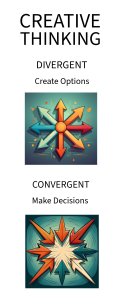4 Creative Problem Solving
Creative Problem Solving as a Skill and a Process
Creative problem solving, or creative thinking, is vital for your team to approach your case successfully. Unlike a talent that some people are simply born with, creative thinking is a skill that can be developed and refined. It involves two distinct processes: divergent thinking and convergent thinking.
Divergent thinking is the first step, where team members generate a wide range of ideas and possibilities without judgment. This phase encourages open-mindedness and the exploration of various perspectives, fostering an environment where innovation can thrive. Once a diverse set of options is on the table, the team transitions to convergent thinking.
This second phase focuses on evaluating the ideas, narrowing them down, and making decisions that align with the team’s goals. By separating these two processes, teams can maximize their creative potential and ensure that the best ideas are identified and implemented. This structured approach not only enhances the quality of business presentations but also promotes collaboration, as team members feel valued for their contributions and are more engaged in the process. Ultimately, mastering the creative process equips teams with the tools to deliver compelling and effective presentations.

Exercises for Divergent Thinking
Free Writing: Free writing is an exercise where individuals write continuously for a set period without worrying about grammar, spelling, or topic constraints. The goal is to unlock creativity and overcome writer’s block by allowing thoughts to flow freely onto the page. This technique helps in generating ideas, clarifying thoughts, and improving writing fluency.
30 Circles: The 30 Circles exercise involves giving participants a sheet with 30 blank circles and asking them to transform as many circles as possible into recognizable objects within a limited time, usually three minutes. This activity encourages divergent thinking by pushing participants to generate a variety of ideas quickly, fostering creativity and flexibility in problem-solving.
SCAMPER Method: SCAMPER is a structured brainstorming technique that stands for Substitute, Combine, Adapt, Modify, Put to another use, Eliminate, and Rearrange. It prompts users to ask specific questions about an existing product, service, or idea to explore new possibilities and improvements. This method helps teams innovate by systematically examining different aspects and potential changes.
Exercises
Guide for Convergent Decision Making in Teams
Once you and your teammates have created some options to explore, it’s time to make some decisions. This is called convergent thinking. Use the following set of questions to guide your discussion on which options would be the best to pursue in achieving your goals.
- Relevance and Alignment:
- How well does each option align with our overall goals and objectives?
- Which options best address the problem or opportunity we are focusing on?
- Feasibility and Resources:
- What resources (time, budget, personnel) are required for each option?
- Are these resources available, and can we realistically implement the option?
- Impact and Benefits:
- What are the potential benefits and positive impacts of each option?
- How will each option affect our stakeholders (customers, team members, etc.)?
- Risks and Challenges:
- What are the potential risks and challenges associated with each option?
- How can we mitigate these risks and overcome the challenges?
- Innovation and Differentiation:
- How innovative is each option compared to existing solutions?
- Does the option offer a unique advantage or differentiation in the market?
- Scalability and Sustainability:
- Can the option be scaled up or adapted for future growth?
- Is the option sustainable in the long term?
- Feedback and Consensus:
- What feedback do we have from team members and other stakeholders?
- Is there a consensus or strong support for any particular option?

